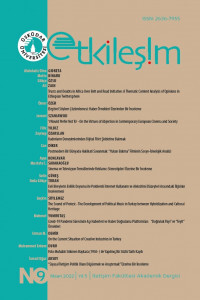Emoji and Nonverbal Communication: An Examination of Social Networking Sites
emoji, nonverbal communication, communication, social networking sites
Emoji ve Sözsüz İletişim: Sosyal Ağ Siteleri Üzerine Bir İnceleme
___
- Birdwhistell, R. L. (1952). Introduction to kinesics: An annotation system for analysis of body motion and gesture. Louisville, KY: Louisville University Press.
- Brisson, C. (2015). Hieroglyphs at our fingertips: Language, semiotics and communication through emoji. https://www.academia.edu/12568625/Hieroglyphs_ at_Our_Fingertips_Language_Semiotics_and_Communication_through_Emoji.
- Derks, D., Fischer, A. H., Bos, A. E. (2008). The role of emotion in computer mediated communication: A review. Computers in Human Behavior, 24, 766-785.
- Dresner, E. and Herring, S.C. (2010). Functions of the nonverbal in CMC: Emoticons and illocutionary force. Communication Theory, 20, 249-268. Emogi Research Team. (2015). Emoji report. https://cdn.emogi.com/docs/reports/2015_emoji_report.pdf.
- Fast, J. (1970). Body language. New York: Neirenberg.
- Hinz, L. (2015). The functions of emoticons and pictograms in instant messengers. Living Linguistics, 92-103.
- Innocent, T. and Haines, S. (2007). Nonverbal communication in multiplayer game worlds. Proceedings of the 4th Australasian Conference on Interactive Environment. RMIT University, Melbourne, Australia.
- Jibril, T. and Abdullah, M. (2013). Relevance of emoticons in computer-mediated communication contexts: An overview. Asian Social Science, 9(4), 201-207.
- Kumari, R. and Ganagwar, R. (2018). A critical study of digital nonverbal communication in interpersonal and group communication: In context of social media. International Journal of Communication and Media Studies (IJCMS, 8(4) 1-12.
- Li, L. and Yang, Y. (2018). Pragmatic functions of emoji in internet based communication---a corpus-based study. Asian-Pacific Journal of Second and Foreign Language Education, https://doi.org/10.1186/s40862-018-0057-z.
- Luor, T., Wu, L. L., Lu, H. P. and Tao, Y. H. (2010). The effect of emoticons in simplex and complex task-oriented communication: An empirical study of instant messaging. Computers in Human Behavior, 26(5), 889-895.
- Lupyan, G. and Dale, R. (2016). Why are there different languages? The role of adaptation in linguistic diversity. Trends in Cognitive Sciences, 20(9), 649-660.
- Maíz-Arévalo, C. (2015). Typographic alteration in formal computer-mediated communication. Procedia - Social and Behavioral Sciences, 212, 140-145.
- Mitchell, A. A. (1986). The effect of verbal and visual components of advertisements on brand attitudes and attitude toward the ad. Journal of Consumer Research, 13, 12-24.
- Newman, N., Fletcher, R., Kalogeropoulos, A. and Nielsen, R.K. (2019). Reuters Institute digital news report 2019. Reuters Institute. https://reutersinstitute. politics.ox.ac.uk/sites/default/files/2019-06/DNR_2019_FINAL_0.pdf.
- Provine, R. R., Spencer, R. J. and Mandell, D. L. (2007). Emotional expression online emoticons punctuate website text messages. J Language Social Psychology, 26(3), 299-307.
- Sakai, N. (2013). The role of sentence closing as an emotional marker: A case of Japanese mobile phone e-mail. Discourse, Context and Media, 2, 149-155.
- Sampietro, A. (2015). Are emoji the new punctuation marks? Insights from Whatsapp chats. Approaches to Digital Discourse Analysis (1-18). Valencia.
- Stark, L. and Crawford, K. (2015). The conservatism of emoji: Work, affect, and communication. Sage Publication.
- Thompson, P. A. and Foulger, D. A. (1996). Effects of Pictographs and quoting on flaming in electronic mail. Computers in Human Behavior, 12, 225-243.
- Walther, J. B. (1996). Interpersonal effects in computer-mediated interaction: A relational perspective. Communication Research, 19(52), 52-90.
- ISSN: 2636-7955
- Yayın Aralığı: Yılda 2 Sayı
- Başlangıç: 2018
- Yayıncı: Üsküdar Üniversitesi
Covid-19 Salgını ve Sağlık Haberciliği: Prof. Dr. Erkan Yüksel ile Söyleşi
Hakikatin Ölümü ya da Ölümlü Hakikat
Orhan Koloğlu’nun Basın Tarihine Katkıları
Emoji and Nonverbal Communication: An Examination of Social Networking Sites
Yeni Medyada Dijital Hikâye Anlatısına Yeni Bir Yaklaşım: Haber Oyunları
Twitter Gazeteciliği ile İlgili Yapılan Lisansüstü Tezlerin İncelenmesi
Muzaffer ŞAHİN, Adalet GÖRGÜLÜ AYDOĞDU
George Gerbner’ın Yetiştirme Kuramına Özgün Bir Katkı: “Kamular Türkü Söyleyin”
Renklerin İndirim Algısına Etkisi Üzerine Bir Nöropazarlama Araştırması
The Representation of the Monster as the Castrating Mother: The Psychoanalytical Approach to Mama
